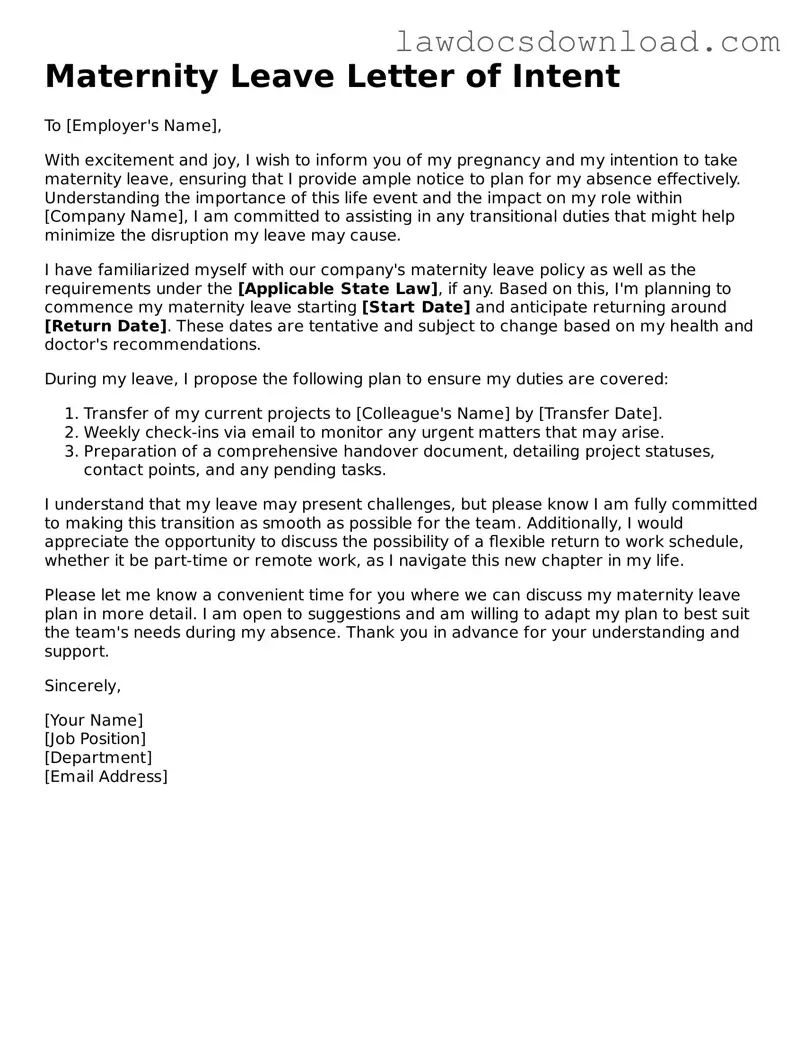The Maternity Leave Letter of Intent is closely related to a Medical Leave Request Form. Both serve the purpose of notifying an employer about an employee's need for time off due to health-related concerns; however, the Maternity Leave Letter of Intent specifically addresses the need for absence due to childbirth and postpartum recovery, while a Medical Leave Request Form covers a broader range of medical conditions and situations that may require an employee's temporary departure from work.
Similar to the Maternity Leave Letter of Intent, a Family Medical Leave Act (FMLA) Request Form is used by employees to seek leave for serious health conditions affecting them or their immediate family members. The critical comparison lies in the FMLA form's broader application for various medical reasons, including but not limited to maternity leave, thus encompassing a wider spectrum of family and medical leave possibilities.
Another document akin to the Maternity Leave Letter of Intent is a Paternity Leave Letter. While both are driven by the arrival of a new child, the Paternity Leave Letter is specifically tailored for fathers or non-birthing parents to request time off to care for their newborn or newly adopted child, signifying the inclusive nature of parental leave policies within modern workplaces.
An Adoption Leave Letter shares similar intentions with the Maternity Leave Letter of Intent, as both aim to secure time off from work to welcome a new child into the family. However, the Adoption Leave Letter focuses on the needs surrounding the adoption process, including but not limited to bonding with the adopted child, which may not align with the physical recovery needs addressed by maternity leave.
The Return to Work Letter, often a follow-up to the Maternity Leave Letter of Intent, is crafted by employees preparing to resume their duties after maternity leave. This document typically outlines the employee’s readiness to return, any requests for work adjustments, or the need for a gradual return to full-time hours, emphasizing the transition period back into the workplace environment.
A Doctor’s Note for Pregnancy is another document related to the Maternity Leave Letter of Intent. This note may be required as supplementary documentation to formally support the need for maternity leave, indicating the anticipated due date and any medical recommendations for workplace accommodations or early leave due to pregnancy complications.
The Work-from-Home Request due to Pregnancy is crafted by expectant mothers seeking to rearrange their work setting to accommodate pregnancy-related needs, making it a precursor or alternative to a full maternity leave. While it focuses on amending the work environment rather than requesting a complete absence from work, it resonates with the proactive planning seen in the Maternity Leave Letter of Intent.
A Disability Leave Letter, similar in purpose to the Maternity Leave Letter of Intent, is utilized when an employee must take leave due to a qualifying disability, which can include complications arising during pregnancy. The document emphasizes the medically necessitated absence from work, highlighting the parallel in the need for workplace support and understanding in both scenarios.
A Reduced Hours Request Letter is comparable to the Maternity Leave Letter of Intent in that it may precede or follow the maternity leave period. Employees seeking to lessen their work hours for reasons related to pregnancy, childbirth, or parenting responsibilities draft this letter to propose a temporary adjustment in their work schedule, aiming for a balance between professional responsibilities and personal health or family needs.
Last but not least, the Breastfeeding Support Request Letter can be seen as a complement to the Maternity Leave Letter of Intent. Upon returning to work, nursing mothers may submit this document to request accommodations that facilitate breastfeeding, such as breaks or a private space to pump breast milk. This letter underscores the ongoing need for workplace support even after the formal maternity leave period has concluded.
